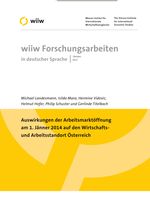Auswirkungen der Arbeitsmarktöffnung am 1. Jänner 2014 auf den Wirtschafts- und Arbeitsstandort Österreich
Helmut Hofer, Michael Landesmann, Isilda Mara, Philip Schuster, Gerlinde Titelbach and Hermine Vidovic
wiiw Research Report in German language No. 2013-10, October 2013
85 pages including 26 Tables and 28 Figures
Summary
Impact of opening full labour market access to Bulgarians and Romanians as of 1 January 2014: the case of Austria
The study analyses the migration potential and the impact on Austria’s economy that is to be expected after the lifting of access restrictions for Bulgarian and Romanian nationals as of 1 January 2014. Estimates show that in the years 2014 and 2015 net migration from the EU-2 to Austria will account for 5700 and 5300 additional migrants, respectively, solely due to the full liberalisation of the labour market. About three quarters of EU-2 migrants are expected to come from Romania.
The macroeconomic impact of opening the labour market in January 2014 is being assessed by using the general equilibrium model TaxLab. Given the fact that persons with a higher educational level may work in Austria already now under certain conditions, it can be expected that after the liberalisation larger shares of persons with a lower level of education will migrate to Austria. The simulations reveal that in the years following the opening of the labour market, employment will be by about 6700 persons higher than it would be without liberalisation in 2014 and by about 10,300 persons above that level in 2015. The employment effect results not only from the higher population flows but also from the activation of a part of those Bulgarian and Romanian migrants who have been resident in Austria already before the liberalisation. The additional labour force supply together with labour market frictions cause a temporary marginal increase in the overall unemployment rate by only 0.03 percentage points in both 2014 and 2015.
The additional labour supply will have a very minor dampening effect on wage growth. As compared to a scenario where the current restrictions are maintained, wages will rise by about 0.2 percentage points more slowly. The strongest losses in wage growth will occur for the low-skilled and the smallest losses in the case of the high-skilled workforce. As a result of the rise in employment and the increased capital stock, value-added will rise as well. The simulation shows that gross domestic product in 2014 and 2015 will be higher by about 0.09% and 0.13%, respectively, than it would be without labour market liberalisation.
Keywords: migration, EU accession – Bulgaria and Romania, impact on EU labour markets, impact on Austria, labour mobility, forecasts and impact analysis
JEL classification: J00, J61, J21, J11, J82, E17
Countries covered: Austria, Bulgaria, New EU Member States, Romania
Research Areas: Macroeconomic Analysis and Policy, Labour, Migration and Income Distribution
